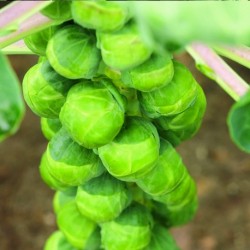



Long Island brussels sprout is a heirloom, semi - dwarf variety, growing only 60 - 70 cm tall. Ideal in a windy, exposed garden or allotment. The quick growing plants produce tasty crop which is ready to harvest from late October - January.
The slow growing Brussels sprouts are an easy and interesting addition to a home garden. Their tall stalks covered with small cabbage-like heads, called sprouts, from top to bottom make them a sight to be seen.
Brussels sprouts are a hardy, cool weather vegetable that need a long season to mature. Their quality improves in cool to lightly frosty temperatures. The best weather for them is under 21C.
Planting
To get an autumn harvest of Brussels sprouts, plant seeds or transplants in June and July. Depending on the weather in your location, this will most likely be the best option. Brussels sprouts growth will stagnate in summer temperatures so planting them early does nothing to help them mature any faster.
If you are direct seeding them in your garden, sow the seeds 4 months before the expected first frost in your area. Plant seeds in soil 1/2” deep, 12-18 inches apart. Rows should be 2 feet apart.
Transplants should be started in late May to be ready for a late June or early July planting.
If you would like a summer harvest, look for Brussels sprouts varieties that are heat resistant and have shorter grow times. Start them indoors and transplant them 2-3 weeks before the last frost date. The seedlings need to be started 5-6 weeks before you intend to plant them.
Watering & Care
Even soil moisture is the best. Brussels sprouts do well with a deep, weekly watering, approximately 1-2 inches per week.
It is thought by many Brussels sprouts growers that removing the bottom leaves off the stem when the sprouts start to develop will quicken the harvest. The lowermost 6-8 leaves are removed right when the sprouts start growing. Then, every week, two or three additional leaves are taken off. The biggest, healthiest, leaves on the upper part of the plant should never be removed. These are how the plant is feeding the sprouts.
The most common problem Brussels sprouts gardeners encounter is club foot. This disease affects all Brassica species, like cabbage, cauliflower, kale and broccoli. This disease is entirely avoidable, unless it is already in the soil from a previous gardening effort in that location. The seriousness of this disease can't be harped on enough, as once it occurs, it will stay in the soil for years and sometimes decades.
If you see stunted foliage growth and leaf deformity, this is the first sign. The leaves quite often have a bluish hue. When the weather gets warm, the plants will wilt quickly. This happens because the infected roots are too weak to support the plant growing above ground. Dig up these plants and check them for distorted, enlarged, roots, which may also be rotting and black. Burn these. Get them out of your garden! Also, wash your boots and any gardening tools you used in that area.
The best and easiest way to avoid club foot is to practice crop rotation. Do not plant any vegetable from the Brassica family in the same space as any were grown in the past 3-4 years. This prevents buildup of the pest. The next best way to prevent club foot is to test the pH of your soil. This disease likes overly acidic soil.
Harvesting
When the sprouts have reached 1-2 inches in diameter and are firm and compact, they are ready to be harvested. The sprouts on the bottom of the plant develop first and should be cut first. You can harvest the sprouts individually, cutting them off the stem as they become mature. When you remove the bottom ones, and as you move up the stem, the plant will concentrate its resources on the ones that remain, quickening their maturity.
Alternately, if you would like to have more uniform sprouts, about 3 weeks before harvest, cut the growing point off at the top of the plant. If all the sprouts mature together, you can cut the entire stem off at harvesting. All sprouts should be harvested before the stem turns yellow. The sprouts shouldn't have any signs of wilting or yellowing or their flavor will be off.
Try not to store Brussels sprouts too long. They are ok in the refrigerator, unwashed, for a few days. After that, their quality begins to deteriorate.
Common Problems
If you find that your sprouts aren't holding a compact shape and are more like a lose cluster of leaves, it is because of heat. There isn't anything you can do to fix this unless you can control the temperature. In the future, try planting later so the sprouts are growing during the cooler fall weather. If the autumn was unseasonably warm, it may just not be the year for great Brussels sprouts.